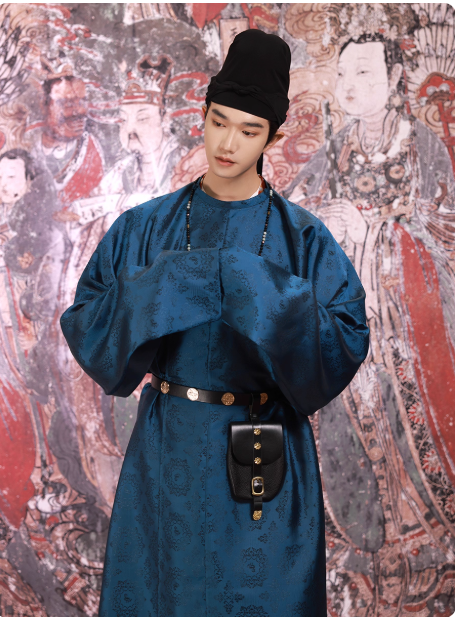The Tang Dynasty (618–907 CE) is celebrated as a pinnacle of Chinese cultural flourishing, and its Hanfu epitomized this era’s cosmopolitan elegance, artistic innovation, and social liberalism. Clothing became a canvas for displaying wealth, status, and aesthetic daring, reflecting China’s interactions with Silk Road cultures and its internal embrace of creative freedom.
Silhouette and Structure
Tang Hanfu broke from earlier constraints to prioritize voluminous cuts, layered draping, and dramatic silhouettes. Women’s fashion iconicized the high-waisted skirt (齐胸襦裙 qixiong ruqun) paired with a short, often sheer jacket (衫 shan), creating an elongated, graceful line. The wide sleeves and flowing skirts were designed to amplify movement, whether in court dances or daily life. Men wore round-collar robes (圆领袍 yuanlingpao) with narrow sleeves, influenced by Central Asian equestrian culture, alongside traditional cross-collar robes (交领袍 jiaolingpao).


Fabrics and Colors
Luxury defined Tang attire: brocades, transparent silks, and embellished gauzes were lavishly used. Aristocrats adorned garments with gold-wire embroidery (盘金绣 panjin xiu) depicting peonies, phoenixes, and scrolling vines. Colors were exuberant—vibrant reds, purples, greens, and yellows—challenging earlier reserved palettes. The famous "pomegranate-skirt" (石榴裙 shiliuqun), dyed in brilliant red, became a symbol of Tang women’s confidence.
Gender Expression and Accessories
Women’s fashion was particularly revolutionary: low necklines, half-bare shoulders, and foreign-inspired hairstyles (e.g., cloud chignons adorned with gold combs and fresh flowers) defied previous modesty norms. Men accessorized with leather belts (蹀躞带 diexiedai) hung with small tools, reflecting functional fashion. Both genders used perfumed sachets and pearl necklaces to display refinement.

Cultural Synthesis and Symbolism
Tang Hanfu integrated influences from Persia, India, and the Turkic kingdoms, seen in floral patterns, Buddhist motifs, and equestrian-inspired cuts. Clothing hierarchies persisted—officials wore rank-specific colors (e.g., purple for highest ranks)—but private attire embraced experimentation. The court’s "Twelve-Layered Dress" (十二破裙 shier poqun) symbolized extreme luxury with its multiple silk layers.
Modern Revival
Today, Tang-style Hanfu is synonymous with romantic grandeur. Designers replicate its bold colors, floral brocades, and voluminous skirts for festivals and photoshoots, celebrating its fusion of tradition and audacity.






